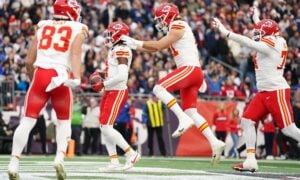Roster Construction – 401k Style
I recently joined the DLF Podcast to talk about how I approach building my rosters. I referenced a concept illustrating that I construct my rosters not like a stock portfolio, but like a 401(k). I am not a day-trading dynasty player. I view my teams in three to four-year windows, never sacrificing the short term for the long, but never sacrificing the long term for the short, either.
General Idea
When I come up with a plan on a how to structure my 401(k), there are some truths about myself I need to be honest about. How much risk am I comfortable with? If I put too much in high growth volatile stocks, would I be fine if the worst case scenario played out? What is my outlook (relative to my age), when do I plan to retire, etc? I need to set a general idea about how far out it will be before I am looking to “cash out.” Our outlooks may vary, but our deliberate approach to our construction must be strong and calculated. With my dynasty rosters, I want results from the first year until the last. I never want to sacrifice a year with the hope that over investing in high-growth players will realize their potential. I have been a Patriots fan all my life. I have never seen a year where Robert Kraft (owner of the Patriots) stockpiled early-round picks and punted on a year. Sure, you may counter and say that’s a business, or that’s the NFL. I choose to have the same mindset. Give me a core of Tom Brady, and for this discussion, Belichick, and let’s go from there.
Many of these questions draw parallels to dynasty for me. How far out am I comfortable with before I cash-out, literally. Do I want to win a title in the first two years then go from there? Do I want to make the long play and try to set myself up for dominance in years five through eight? How should I allocate my funds? Should I have 50 percent spent on veterans on the back-nine of their career? Should I have 80 percent on the strategy often referred to as “win now.” Or do I want to have 80 percent invested on up-and-coming blue chip prospects, with the calculated assumption that years one through three might be rocky. With many hobbies which have financial implications, I like to win early, then roll the winnings forward. For example, I started with a few leagues, joined more leagues with those winnings. I find I enjoy my hobbies more when I am playing with “house money.” Obviously, this is a personal preference. Many people play dynasty for different reasons. Whether they play for pure fun and money is no concern, whether they purely play for the money or even join leagues with the expectation they won’t be competitive for the first couple of years. While I don’t knock anyone for their own personal approach, mine is to never punt, never submit and always moving to one goal: winning titles. Some of this attitude comes from my redraft experience – in redraft I fight weekly, every lineup decision, every injury, and every win matters. I have won many redraft titles before I started dynasty and a good amount of those where in years I had a bad draft and made good moves in season to make the playoffs and push for a title. Applying this to dynasty, I focus on drafting well, working the waiver wire and making supplemental trades. I want every one of my teams to be at worst, playoff bound, betting on myself that I can make solid in-season moves if necessary to win a title. With that said, the challenge in dynasty vs. redraft is to stay within a mindset that you don’t deal from your prospects or future assets too heavily, leaving yourself too thin. This doesn’t mean you can’t make in-season trades, just have to be smart about it.
Allocation
As with my 401(k), I generally have 50 percent in what I would refer to as my core. This 50 percent is allocated to mid-growth, mid-cap type funds. These would be players whom I would consider to be in the middle of their careers – receivers such as Antonio Brown, Julio Jones, Jeremy Maclin, Golden Tate, Mark Ingram, etc. These players share a common thread of being productive, yet in the peak of their playing careers, in terms of not only age, but expected career lengths. These core players can range in level of production from being my top producing receiver, or my steady high floor RB2, they all have a role to file within the fabric of my dynasty portfolio of a roster.
The other 50 percent I split into two categories – high growth, high risk (otherwise known as small-cap), and low growth, low risk (otherwise known as large cap). To fill the 25 percent of small cap, I like players like Eric Ebron, Kendall Wright, Willie Snead, Ty Montgomery, Devin Funchess, etc. These players have relatively lower cost, but have decent potential for growth. My draft picks would also contribute to this part of my roster construction. For the last 25 percent, my large cap, I like to have players like Larry Fitzgerald, Matt Forte, Jamaal Charles, Brandon Marshall, Jordy Nelson, etc. These players can also have varying acquisition costs, but serve a viable purpose for my lineup producing points; I don’t necessarily need these players to be high ceiling players, or long term players on my roster, but can reasonably expect short term 1-2 years of a medium level floor.
Conclusion
Constructing a dynasty team will always be debated heavily across the community. There is no cookie cutter approach, no matter how you personally construct your roster. The best I can offer is my approach from the success and mistakes I’ve made along my way. For me, the absolute worst case is when your team has no identity and no organization. Many can suggest you just acquire talent, and while that is always a good thing, for many it becomes a problem when it comes time to fill out a roster and transition from year-to-year. You really should have a framework in mind how each player fits into your bigger picture. This framework will guide you when determining who on your roster is expendable, and who is a key part of your core and also which players are filling a depth or supplemental role. Never let anyone tell you that you can’t win now, win later and also win consistently.
- 2023 Dynasty Fantasy Football Rookie Prospect: Jalin Hyatt, WR Tennessee - April 6, 2023
- 2021 Summer Sleeper: Las Vegas Raiders - August 14, 2021
- 2021 Summer Sleeper: Cincinnati Bengals - August 13, 2021


































































